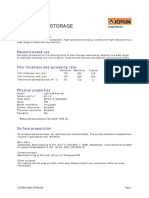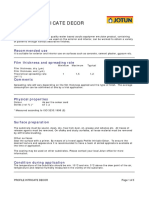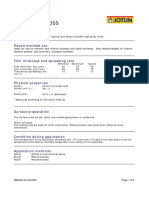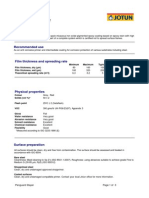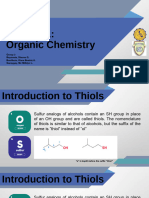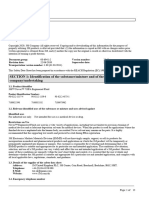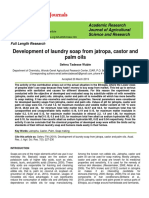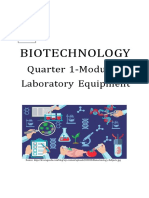TDS - ANODESHIELD ICCP - English - Issued.12.02.2002
TDS - ANODESHIELD ICCP - English - Issued.12.02.2002
Uploaded by
DmitryCopyright:
Available Formats
TDS - ANODESHIELD ICCP - English - Issued.12.02.2002
TDS - ANODESHIELD ICCP - English - Issued.12.02.2002
Uploaded by
DmitryCopyright
Available Formats
Share this document
Did you find this document useful?
Is this content inappropriate?
Copyright:
Available Formats
TDS - ANODESHIELD ICCP - English - Issued.12.02.2002
TDS - ANODESHIELD ICCP - English - Issued.12.02.2002
Uploaded by
DmitryCopyright:
Available Formats
Technical Data
ANODESHIELD ICCP
Product description
Anodeshield ICCP is a practically solvent-free, abrasion resistant, two-pack epoxy coating which
contains glass flakes.
Recommended use
A high build, practically solvent free coating for steel subjected to extreme submerged exposure and
mechanical impact. Particularly suitable as anode shield in impressed current cathodic protection
systems.
Film thickness and spreading rate
Minimum Maximum Typical
Film thickness, dry (µm) 250 650 400
Film thickness, wet (µm) 250 650 400
Theoretical spreading 4 1,5 2
rate (m²/l)
Physical properties
Colour Grey, Red
Solids (vol %)* 98 ± 2
Flash point >55ºC (Setaflash)
Gloss Glossy
Gloss retention Fair
Water resistance Excellent
Abrasion resistance Excellent
Solvent resistance Excellent
Chemical resistance Excellent
Flexibility Fair
Compatibility with
cathodic protection Excellent
*Measured according to ISO 3233:1998 (E)
Surface preparation
All surfaces should be clean, dry and free from contamination. The surface should be assessed and
treated in accordance with ISO 8504.
Bare steel
Cleanliness: Blast cleaning to min. Sa 2 ½ (ISO 8501 1:1988), Roughness: use suitable abrasives to
achieve Grade Coarse G (85 - 130 µm, Ry5) (ISO 8503-2).
Other surfaces
The coating may be used on other substrates. Please contact your local Jotun office for more
information.
ANODESHIELD ICCP Page 1 of 4
Condition during application
The temperature of the substrate should be minimum 10°C and at least 3°C above the dew point of
the air, temperature and relative humidity measured in the vicinity of the substrate. The coating
should not be exposed to oil, chemicals or mechanical stress until fully cured.
Application methods
Spray Two-comp. heated airless spray
Brush Stiff nylon brush
Other Putty knife
Application data
Mixing ratio (volume) 2 parts comp. A (base) to be mixed thoroughly with 1 part Comp. B
(curing agent).
Pot life (23°C) 30 minutes. In two-comp. spray at 40°C - 5 minutes.
Thinner/Cleaner Jotun Thinner No. 17Do not thin when used as anodeshield.
Guiding data airless spray
Pressure at nozzle 20 MPa (200 kp/cm² 2800 psi).
Nozzle tip 0.63-1.09 mm (0.025-0.043").
Spray angle 40-80º
Filter Remove all filters.
Drying time
Drying times are generally related to air circulation, temperature, film thickness and number of coats,
and will be affected correspondingly. The figures given in the table are typical with:
* Good ventilation (Outdoor exposure or free circulation of air)
* Typical film thickness
* One coat on top of inert substrate
Substrate temperature 10°C 23°C 40°C
Surface dry 10 h 4h 2h
Through dry 16 h 7h 3,5 h
Cured 14 d 7d 3d
Dry to recoat, minimum 16 h 7h 3,5 h
Dry to recoat, maximum 5d 3d 2d
1
1. The surface should be free from chalking and contamination prior to application. If the maximum
dry to recoat time is exceeded, please contact Jotun Paints for advice.
The given data must be considered as guidelines only. The actual drying time/times before recoating
may be shorter or longer, depending on film thickness, ventilation, humidity, underlying paint system,
requirement for early handling and mechanical strength etc. A complete system can be described on
a system sheet, where all parameters and special conditions could be included.
Typical paint system
Blast cleaning to Sa 2½:
Anodeshield ICCP 2 x 400 µm (Dry Film Thickness)
An approved primer 1 x 150 µm (Dry Film Thickness)
ANODESHIELD ICCP Page 2 of 4
(For overcoating, please contact Jotun Paints for advice.)
Other systems may be specified, depending on area of use
Brief application procedure:
1. The steel is to be blast cleaned to at least Sa 2½ (ISO 8501-1:1988). To obtain a good anchor
pattern the surface roughness should be minimum 50 microns.
2. The steel temperature should be min. 3°C above the dewpoint of the air close to the steel
surface when the paint is applied.
3. Shortly after blast cleaning and before any rust is visible, the first coat is to be applied. The
two-pack epoxy is to be applied by stiff nylon brushes or putty-knives. It is important that the
coating is thoroughly worked into the steel substrate to secure the best adhesion.
Two-component, heated airless spray can also be used.
4. The second coat is to be applied as soon as the first coat is sufficiently cured, and not being
too hard. For guidance at least 10 hours at 23°C and at least 20 hours at 10°C between the
coats should be allowed for. The maximum curing time before application of the second coat
should be 3 days at 23°C.
5. To speed up the curing process at low temperature, the use of warm, dry air is recommended.
1. To secure a better adhesion of the antifouling paint it is advisable to apply one to two coats of
primer on top of the shield. The primer should be applied between 3 and 5 days after second
coat of epoxy shield.
Storage
The product must be stored in accordance with national regulations. Storage conditions are to keep
the containers in a dry, cool, well ventilated space and away from source of heat and
ignition.Containers must be kept tightly closed.
Handling
Handle with care. Stir well before use.
Packing size
15 litre unit: 10 litres comp. A (base) in a 20 litre container and 5 litres comp. B (curing agent) in a 5
litre container.
or
3 litre unit: 2 litres comp. A (base) in a 3 litre container and 1 litre comp. B (curing agent) in a 1 litre
container.
Packing may vary from country to country according to local requirements.
ANODESHIELD ICCP Page 3 of 4
Health and safety
Please observe the precautionary notices displayed on the container. Use under well ventilated
conditions. Do not breathe or inhale mist. Avoid skin contact. Spillage on the skin should immediately
be removed with suitable cleanser, soap and water. Eyes should be well flushed with water and
medical attention sought immediately.
For detailed information on the health and safety hazards and precautions for use of this
product, we refer to the Material Safety Data Sheet.
DISCLAIMER
The information in this data sheet is given to the best of our knowledge based on laboratory testing
and practical experience. However, as the product is often used under conditions beyond our control,
we cannot guarantee anything but the quality of the product itself. We reserve the right to change
the given data without notice.
Head Office & Nordic Europe Middle East South East Asia
Jotun Paints Jotun U.A .E Ltd. LLC .
Jotun Paints (Europe) Ltd. Jotun (Singapore) Pte. Ltd.
P.O . Box 2021 No 11 -15 , Sixth Lok Yang
Stather Road, Flixborough
N-3248 Sandefjord North Lincolnshire DN 15 A l Q uoz Industrial A Road
Norway 8 RR rea P.O Box 3671 Jurong
Phone +47 33 45 70 00 United Kingdom Dubai U.A .E Singapore 628 111
Fax +47 33 46 46 13 Phone +44 172 44 00 000 Phone +65 6265 4711
Fax +44 172 44 00 100 Phone +971 4 3 39 50 00 Fax +65 6265 7484
Fax +971 4 3 38 06 66
Jotun is a World Wide company with factories, sales offices and stocks in more than 50 countries. For your
nearest local Jotun address please contact the nearest regional office or visit our website at www.jotun.com
ISSUED 12 FEBRUARY 2002 BY JOTUN
PAINTS THIS DATA SHEET SUPERSEDES THOSE PREVIOUSLY
ISSUED
ANODESHIELD ICCP Page 4 of 4
You might also like
- Improvised Munitions Handbook – Learn How to Make Explosive Devices & Weapons from Scratch (Warfare Skills Series): Illustrated & With Clear InstructionsFrom EverandImprovised Munitions Handbook – Learn How to Make Explosive Devices & Weapons from Scratch (Warfare Skills Series): Illustrated & With Clear InstructionsRating: 3.5 out of 5 stars3.5/5 (7)
- Coal Tar JotunDocument3 pagesCoal Tar JotunIntan100% (1)
- TDS-ANTIFOULING SARGASSO-EnglishDocument3 pagesTDS-ANTIFOULING SARGASSO-EnglishthirdNo ratings yet
- Soldering electronic circuits: Beginner's guideFrom EverandSoldering electronic circuits: Beginner's guideRating: 4.5 out of 5 stars4.5/5 (10)
- Jobs MethodDocument3 pagesJobs MethodKasunBuddika50% (2)
- TDS-ANODESHIELD ICCP-EnglishDocument4 pagesTDS-ANODESHIELD ICCP-EnglishthirdNo ratings yet
- Jotacote UniversalDocument4 pagesJotacote UniversalRidwan BaharumNo ratings yet
- Tankguard StorageDocument3 pagesTankguard StoragedaerobiNo ratings yet
- Dura MasticDocument4 pagesDura MasticMoh. Emil SyamsudinNo ratings yet
- Penguard SpecialDocument3 pagesPenguard SpecialAbay OchNo ratings yet
- ALKYDPRIMERDocument3 pagesALKYDPRIMERMoh. Emil SyamsudinNo ratings yet
- TDS BARRIER EnglishDocument3 pagesTDS BARRIER EnglishthirdNo ratings yet
- Chemtech 340Document3 pagesChemtech 340pardissNo ratings yet
- TDS SAFEGUARD EnglishDocument4 pagesTDS SAFEGUARD EnglishthirdNo ratings yet
- Jotafloor Topcoat Technical Data SheetDocument4 pagesJotafloor Topcoat Technical Data SheetTuan ThanNo ratings yet
- Conseal PrimerDocument3 pagesConseal PrimerpardissNo ratings yet
- Jotashield Alkali Resistant PrimerDocument3 pagesJotashield Alkali Resistant PrimerRaviyanantham RishabananthanNo ratings yet
- TDS MARATHON EnglishDocument4 pagesTDS MARATHON EnglishthirdNo ratings yet
- TDS-JOTABAR ZEP-EnglishDocument3 pagesTDS-JOTABAR ZEP-EnglishthirdNo ratings yet
- TDS - Penguard Midcoat Mio 80Document4 pagesTDS - Penguard Midcoat Mio 80GunarsyahNo ratings yet
- Jota - EtchDocument3 pagesJota - EtchRidwan BaharumNo ratings yet
- Submarine Filler - English (Uk) - Issued.06.12.2007Document4 pagesSubmarine Filler - English (Uk) - Issued.06.12.2007Mohamed FaragNo ratings yet
- Jotafloor SealerDocument4 pagesJotafloor SealerSanthosh KarunanithiNo ratings yet
- Balto FlakeDocument4 pagesBalto FlakeAdarsh PrakashNo ratings yet
- TDS-PENGUARD TOPCOAT-EnglishDocument4 pagesTDS-PENGUARD TOPCOAT-EnglishthirdNo ratings yet
- TDS-PENGUARD HB-EnglishDocument4 pagesTDS-PENGUARD HB-EnglishthirdNo ratings yet
- Jotun HARDTOP AS Data SheetDocument3 pagesJotun HARDTOP AS Data Sheetkey.to.industrial.paintingNo ratings yet
- TDS-JOTACOTE PSO-EnglishDocument3 pagesTDS-JOTACOTE PSO-EnglishthirdNo ratings yet
- Duros AnDocument3 pagesDuros Anismail1112012No ratings yet
- TDS JOTATHANE EnglishDocument3 pagesTDS JOTATHANE EnglishthirdNo ratings yet
- TDS CHEMCLEAR EnglishDocument3 pagesTDS CHEMCLEAR EnglishthirdNo ratings yet
- Tds - Durosan - English - Issued.18.11.2002Document3 pagesTds - Durosan - English - Issued.18.11.2002BNo ratings yet
- Jotacote 5Document4 pagesJotacote 5Ridwan BaharumNo ratings yet
- Tds - Texo Compound - English - Issued.18.11.2002Document3 pagesTds - Texo Compound - English - Issued.18.11.2002BNo ratings yet
- Penguard ZP AO - English (Uk) - Issued.06.12.2007Document3 pagesPenguard ZP AO - English (Uk) - Issued.06.12.2007Mohamed FaragNo ratings yet
- Penguard HB 2005 PDFDocument4 pagesPenguard HB 2005 PDFMuthuKumarNo ratings yet
- Penguard MidcoatDocument4 pagesPenguard MidcoatfirmanNo ratings yet
- Tds - Bengalac Semigloss - English - Issued.18.11.2002Document3 pagesTds - Bengalac Semigloss - English - Issued.18.11.2002BNo ratings yet
- Jotafloor TopcoatDocument4 pagesJotafloor TopcoatrogandatambunanNo ratings yet
- TDS - Penguard Primer - Issued.26.11.2010Document4 pagesTDS - Penguard Primer - Issued.26.11.2010vitharvanNo ratings yet
- Jotazinc PDFDocument4 pagesJotazinc PDFAnonymous YtgIj2A9nWNo ratings yet
- TDS - ANTIFOULING SEAFORCE 60 - English - Issued.02.11.2004Document3 pagesTDS - ANTIFOULING SEAFORCE 60 - English - Issued.02.11.2004DmitryNo ratings yet
- TDS - ROOFGUARD - English - Issued.18.11.2002 PDFDocument3 pagesTDS - ROOFGUARD - English - Issued.18.11.2002 PDFBNo ratings yet
- Tds - Profile Intricate Decor - English - Issued.18.07.2003Document3 pagesTds - Profile Intricate Decor - English - Issued.18.07.2003BNo ratings yet
- Tds - Bengalac Gloss - English - Issued.18.11.2002Document3 pagesTds - Bengalac Gloss - English - Issued.18.11.2002Satish VishnubhotlaNo ratings yet
- Jotun Block FillerDocument3 pagesJotun Block FillerrajeshNo ratings yet
- Tds - Tex Primer - English - Issued.18.11.2002Document3 pagesTds - Tex Primer - English - Issued.18.11.2002BNo ratings yet
- Coal Tar Epoxy 83 - English (Uk) - Issued.06.12.2007Document3 pagesCoal Tar Epoxy 83 - English (Uk) - Issued.06.12.2007Mohamed Farag100% (1)
- Penguard Stayer - English (Uk) - Issued.06.12.2007Document3 pagesPenguard Stayer - English (Uk) - Issued.06.12.2007Mohamed FaragNo ratings yet
- Jotafloor SL UniversalDocument6 pagesJotafloor SL UniversalrogandatambunanNo ratings yet
- J Primer TdsDocument3 pagesJ Primer Tdswey5316No ratings yet
- Penguard FC: Technical DataDocument4 pagesPenguard FC: Technical DataMohamed FarhanNo ratings yet
- Spontan Varnish - English (Uk) - Issued.06.12.2007Document3 pagesSpontan Varnish - English (Uk) - Issued.06.12.2007Mohamed FaragNo ratings yet
- Alkydprimer - English (Uk) - Issued.06.12.2007Document3 pagesAlkydprimer - English (Uk) - Issued.06.12.2007Mohamed FaragNo ratings yet
- Penguard Special - English (Uk) - Issued.06.12.2007Document3 pagesPenguard Special - English (Uk) - Issued.06.12.2007Mohamed FaragNo ratings yet
- Jotatemp 650 (ENG)Document3 pagesJotatemp 650 (ENG)Dedi KartiwaNo ratings yet
- Jotgrd Coal TarDocument3 pagesJotgrd Coal TarMekhmanNo ratings yet
- Jotgrd Coal TarDocument3 pagesJotgrd Coal TarMekhmanNo ratings yet
- Bathtub and Shower Tray Repair: How to prevent remedials and make the repair future-proofFrom EverandBathtub and Shower Tray Repair: How to prevent remedials and make the repair future-proofNo ratings yet
- SDS US - Crystal Clean 142 Mineral Spirits (915876) Revision Date 2-11-15Document7 pagesSDS US - Crystal Clean 142 Mineral Spirits (915876) Revision Date 2-11-15ashadeofdarknessNo ratings yet
- Adhesor Carbofine (Liquid) : Safety Data SheetDocument6 pagesAdhesor Carbofine (Liquid) : Safety Data SheetSmart Dental ClinicsNo ratings yet
- Chemical Bonding Sample PaperDocument5 pagesChemical Bonding Sample PaperUditaNo ratings yet
- Sikaplan WP 5101-15REDocument4 pagesSikaplan WP 5101-15REMarian G. MadalinNo ratings yet
- Welcome To CABBDocument28 pagesWelcome To CABBmizar.g91No ratings yet
- SIKA Dry MortaDocument12 pagesSIKA Dry MortaPhạm ViệtNo ratings yet
- Ölflex® Heat 205 MC: Product InformationDocument4 pagesÖlflex® Heat 205 MC: Product InformationElectroventica ElectroventicaNo ratings yet
- Module - 1 SolutionsDocument23 pagesModule - 1 SolutionsRohit RathodNo ratings yet
- Samp Chem 3Document2 pagesSamp Chem 3Dhruv GoyalNo ratings yet
- Amines and ThiolsDocument103 pagesAmines and ThiolsKarla Joy P. SucgangNo ratings yet
- Kisi Kisi Bhs Inggris Kelas XI Tentang Analytical ExpositionDocument7 pagesKisi Kisi Bhs Inggris Kelas XI Tentang Analytical ExpositionAbdu RasyidNo ratings yet
- 3m Novec 71ipa Engineered Fluid SDSDocument13 pages3m Novec 71ipa Engineered Fluid SDSstudencicazoomNo ratings yet
- CHEM 1412. Chapter 16. Acids and Bases - Homework - SDocument13 pagesCHEM 1412. Chapter 16. Acids and Bases - Homework - STrisha Anne SyNo ratings yet
- Unit-1 - Catalysis and Catalytic ReactorsDocument44 pagesUnit-1 - Catalysis and Catalytic ReactorsAP Naidu UNo ratings yet
- Agro India Jan 2022Document45 pagesAgro India Jan 2022Prathamesh JabareNo ratings yet
- AMAL ProjectDocument36 pagesAMAL ProjectVishnu DasNo ratings yet
- Perfect Powder Measure: GuaranteeDocument2 pagesPerfect Powder Measure: GuaranteewsmartinsNo ratings yet
- Sterile Filtration-Filter-Integrity-Test-TailinDocument15 pagesSterile Filtration-Filter-Integrity-Test-Tailinnawazash100% (1)
- SOP HemoCue HB 201 Plus DMDocument10 pagesSOP HemoCue HB 201 Plus DMМіський центр служби крові ТМО No1No ratings yet
- Aleksandrow Agar: CompositionDocument2 pagesAleksandrow Agar: Compositionanggrek IPBNo ratings yet
- Topical Test Chapter 4 Periodic Table of ElementsDocument3 pagesTopical Test Chapter 4 Periodic Table of ElementsIVAN TIONG WEI JUN Moe50% (2)
- Phytochemical and Pharmacological Studies On Wrightia TinctoriaDocument24 pagesPhytochemical and Pharmacological Studies On Wrightia TinctoriaDr. Ramadevi DevarakondaNo ratings yet
- Development of Laundry Soap From Jatropa, Castor and Palm OilsDocument4 pagesDevelopment of Laundry Soap From Jatropa, Castor and Palm OilsLeencie Sande100% (1)
- Intelligent Materials Breaking New Grounds in Dentistry - 110621210536Document5 pagesIntelligent Materials Breaking New Grounds in Dentistry - 110621210536flickers xxxNo ratings yet
- Krisof Lub NG - TdsDocument3 pagesKrisof Lub NG - TdsSuperNo ratings yet
- Biotech - Q1 Module 2Document19 pagesBiotech - Q1 Module 2dasdas100% (2)
- A Qualitative Study: Acid Rain VS Concrete StructuresDocument3 pagesA Qualitative Study: Acid Rain VS Concrete StructuresMarvee DaplianNo ratings yet
- The Fundamentals of Weld Metal Pore Formation: R.E. TrevisanDocument37 pagesThe Fundamentals of Weld Metal Pore Formation: R.E. TrevisandietersimaNo ratings yet
- Mesh Micron Sizes Chart Ebook From IsmDocument7 pagesMesh Micron Sizes Chart Ebook From IsmPratik JainNo ratings yet








